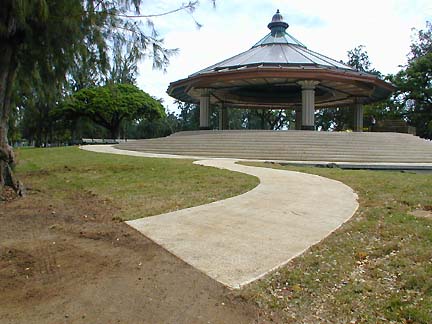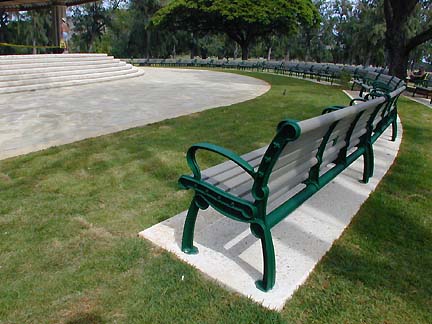Advertisement - Click to support our sponsors.


Kapiolani Park's new bandstand, which opened to an enthusiastic Fourth of July crowd, has some significant flaws, says Francine Wai, whose office oversees laws governing access for the disabled.
Wai, executive director of the State Disability and Communication Access Board (formerly Commission on Persons With Disabilities), was among those looking at the city's newest structure Tuesday.
Wai said that she had met with architects for the project but that final plans weren't submitted to her office by the city Department of Design and Construction until about noon yesterday -- after she and the Star-Bulletin had inquired about the situation.
Building plans must be reviewed by Wai's office before construction to see if they meet requirements of the Americans With Disabilities Act.
Wai said she won't know how well the bandstand complies with the law until she has a chance to study the plans.
But she knows from observations and reports that there are access problems.
She said there is no access for disabled persons to the lower level, where the performers' dressing rooms and storage facilities are located.
And there is no wheelchair access to seats in the audience, she said. "As far as I can tell, there is no route to get to the seats."
City Managing Director Ben Lee said, "It's a well-received facility. We thought it would be unfair not to have the facility open to the general public."
But he said the project still is in the construction phase.
"We are still going through a punch list with the contractor -- things that need to be corrected ... We're working with the contractor to identify items that need to be finished off, or minor adjustments, what we call fine-tuning of the facility.

"The bigger picture here is to make sure all state, federal and city facilities comply with ADA requirements," Lee said. "I believe all our city projects certainly try to do that. If any kinds of modifications are needed, we would do that."He said there is space for a lift that will be installed to the bandstand's lower level as soon as it arrives from the mainland. It will provide access for disabled persons to the bandstand stage area and dressing rooms, he said.
As for seating, he said a concrete apron about 25 to 30 feet wide in front of the bandstand was designed for wheelchairs. Several hundred portable chairs in storage can be used by family members and friends wishing to sit by those in wheelchairs, he said.
"He can talk until he's blue in the face but that's not acceptable," Wai said.
Putting all wheelchairs in one location is clustered seating that doesn't comply with the law when there is fixed seating, she said.
"You must have integrated and dispersed seating for persons with disabilities adjacent to regular seating. ... There needs to be a firm, stable, slip-resistant surface to get there."
Wai said the plans submitted include not only the bandstand but park improvements such as a new comfort station and renovations to the existing one.
Those and other features, such as toilets in the lower dressing room area, must be examined for accessibility.
Wai noted that the bandstand has been offered for use by nonprofit groups, which may include performers with disabilities.
"Why is it being open to the public if it isn't accessible? I have run into the attitude, 'We intend to make it accessible, but we're going to start using it.'
"The reality of the civil rights law is, if it's not usable for everybody, then you should not be opening it up to the public."